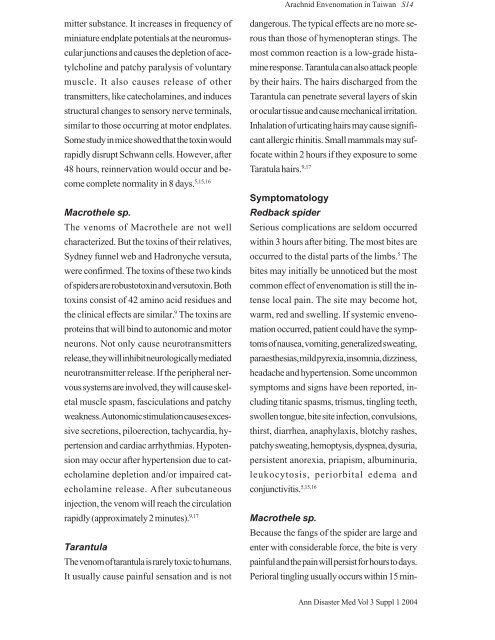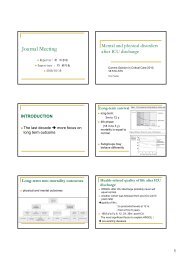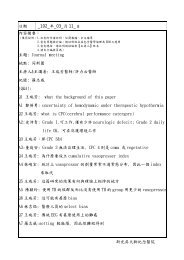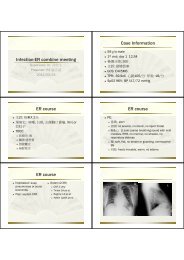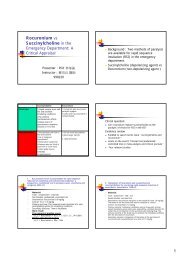Arachnid Envenomation in Taiwan
Arachnid Envenomation in Taiwan
Arachnid Envenomation in Taiwan
Create successful ePaper yourself
Turn your PDF publications into a flip-book with our unique Google optimized e-Paper software.
<strong>Arachnid</strong> <strong>Envenomation</strong> <strong>in</strong> <strong>Taiwan</strong> S14mitter substance. It <strong>in</strong>creases <strong>in</strong> frequency ofm<strong>in</strong>iature endplate potentials at the neuromuscularjunctions and causes the depletion of acetylchol<strong>in</strong>eand patchy paralysis of voluntarymuscle. It also causes release of othertransmitters, like catecholam<strong>in</strong>es, and <strong>in</strong>ducesstructural changes to sensory nerve term<strong>in</strong>als,similar to those occurr<strong>in</strong>g at motor endplates.Some study <strong>in</strong> mice showed that the tox<strong>in</strong> wouldrapidly disrupt Schwann cells. However, after48 hours, re<strong>in</strong>nervation would occur and becomecomplete normality <strong>in</strong> 8 days. 5,15,16Macrothele sp.The venoms of Macrothele are not wellcharacterized. But the tox<strong>in</strong>s of their relatives,Sydney funnel web and Hadronyche versuta,were confirmed. The tox<strong>in</strong>s of these two k<strong>in</strong>dsof spiders are robustotox<strong>in</strong> and versutox<strong>in</strong>. Bothtox<strong>in</strong>s consist of 42 am<strong>in</strong>o acid residues andthe cl<strong>in</strong>ical effects are similar. 9 The tox<strong>in</strong>s areprote<strong>in</strong>s that will b<strong>in</strong>d to autonomic and motorneurons. Not only cause neurotransmittersrelease, they will <strong>in</strong>hibit neurologically mediatedneurotransmitter release. If the peripheral nervoussystems are <strong>in</strong>volved, they will cause skeletalmuscle spasm, fasciculations and patchyweakness. Autonomic stimulation causes excessivesecretions, piloerection, tachycardia, hypertensionand cardiac arrhythmias. Hypotensionmay occur after hypertension due to catecholam<strong>in</strong>edepletion and/or impaired catecholam<strong>in</strong>erelease. After subcutaneous<strong>in</strong>jection, the venom will reach the circulationrapidly (approximately 2 m<strong>in</strong>utes). 9,17TarantulaThe venom of tarantula is rarely toxic to humans.It usually cause pa<strong>in</strong>ful sensation and is notdangerous. The typical effects are no more serousthan those of hymenopteran st<strong>in</strong>gs. Themost common reaction is a low-grade histam<strong>in</strong>eresponse. Tarantula can also attack peopleby their hairs. The hairs discharged from theTarantula can penetrate several layers of sk<strong>in</strong>or ocular tissue and cause mechanical irritation.Inhalation of urticat<strong>in</strong>g hairs may cause significantallergic rh<strong>in</strong>itis. Small mammals may suffocatewith<strong>in</strong> 2 hours if they exposure to someTaratula hairs. 9,17SymptomatologyRedback spiderSerious complications are seldom occurredwith<strong>in</strong> 3 hours after bit<strong>in</strong>g. The most bites areoccurred to the distal parts of the limbs. 5 Thebites may <strong>in</strong>itially be unnoticed but the mostcommon effect of envenomation is still the <strong>in</strong>tenselocal pa<strong>in</strong>. The site may become hot,warm, red and swell<strong>in</strong>g. If systemic envenomationoccurred, patient could have the symptomsof nausea, vomit<strong>in</strong>g, generalized sweat<strong>in</strong>g,paraesthesias, mild pyrexia, <strong>in</strong>somnia, dizz<strong>in</strong>ess,headache and hypertension. Some uncommonsymptoms and signs have been reported, <strong>in</strong>clud<strong>in</strong>gtitanic spasms, trismus, t<strong>in</strong>gl<strong>in</strong>g teeth,swollen tongue, bite site <strong>in</strong>fection, convulsions,thirst, diarrhea, anaphylaxis, blotchy rashes,patchy sweat<strong>in</strong>g, hemoptysis, dyspnea, dysuria,persistent anorexia, priapism, album<strong>in</strong>uria,leukocytosis, periorbital edema andconjunctivitis. 5,15,16Macrothele sp.Because the fangs of the spider are large andenter with considerable force, the bite is verypa<strong>in</strong>ful and the pa<strong>in</strong> will persist for hours to days.Perioral t<strong>in</strong>gl<strong>in</strong>g usually occurs with<strong>in</strong> 15 m<strong>in</strong>-Ann Disaster Med Vol 3 Suppl 1 2004


